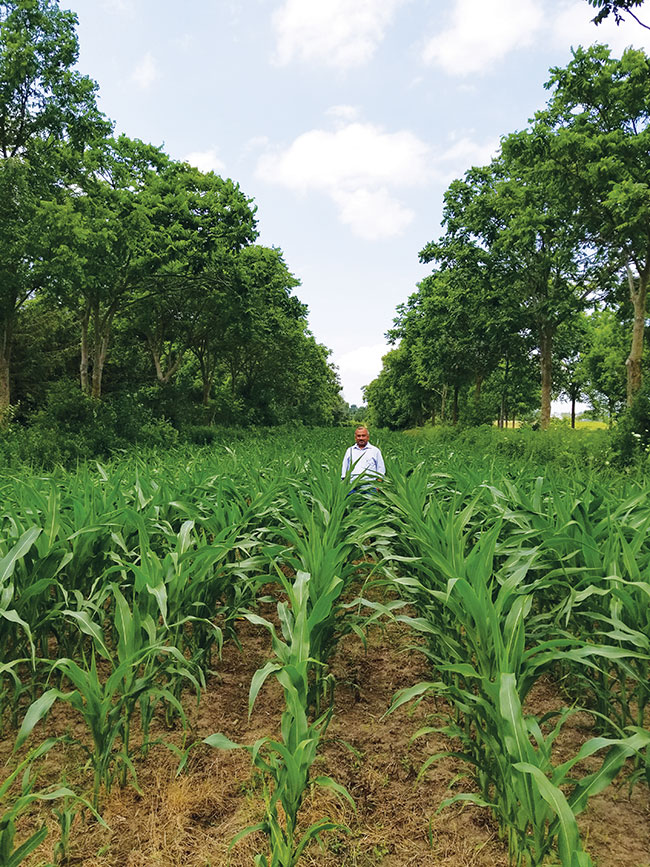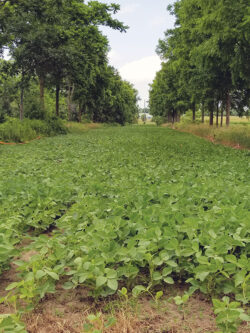
Features
Other Crops
Spruce-ing up the farm
Tree-based intercropping offers Ontario and Quebec producers plenty of economic and ecological benefits.
May 23, 2023 By Julienne Isaacs
 A tree-corn intercrop plot at the University of Guelph.
A tree-corn intercrop plot at the University of Guelph.
Tree-based intercropping is the practice of growing trees in rows between agricultural crops. It’s often called “alley cropping.” And though it isn’t common in Eastern Canada, one researcher believes it’s the way of the future.
“Tree-based intercropping systems are one of the most efficient and manageable nature-based solutions that farmers can do to meet climate goals, and there is high potential for every farm to integrate trees onto their farms,” says Raju Soolanayakanahally, a research scientist with Agriculture and Agri-Food Canada.
Trees are Soolanayakanahally’s specialty. His projects focus on aspects of agroforestry, including breeding climate-adaptive trees for carbon sequestration, riparian planting to intercept nutrient runoff, and shelterbelts.
He says trees that are integrated into agricultural land offer more than a few benefits for the whole ecosystem.
“When it comes to ecological benefits, they help with reducing soil erosion and wind speed on agricultural land. They develop a microclimate between rows that helps to improve soil fertility and serve as a host for natural pest predators and other beneficial insects. They also minimize nutrient leaching and stabilize riparian zones,” says Soolanayakanahally.
Early on, when trees are young, they can compete for nutrients with annual crops, but once they’ve matured (past five years or so) they can harvest water and nutrients from levels much deeper than crops. If deciduous trees are grown in the system, they add carbon and organic matter with leaf drop.
Fewer than 2,000 acres are currently used for tree-based intercropping in Ontario and Quebec, he says. Only small landowners growing specialty or high-value crops like vegetables, garlic and ginseng are trying this land-use system. But there’s a lot of interest in the practice, says Soolanayakanahally: thousands of farmers have asked for more information.
And physically speaking, there’s plenty of room for far more tree-based intercropping in Eastern Canada.
Carbon credits
A recent research paper – whose authorship includes other AAFC researchers, all of them specialists in a wide range of natural climate solutions (NCS) – looks at the potential for tree-based intercropping and other agroforestry practices on existing agricultural land across Canada. Soolanayakanahally, a co-author on the study, says the goal was to build models for 24 NCS to find ways for Canada to meet or even exceed its climate goals.

A tree-soybean intercrop plot at the University of Guelph.
The researchers found that NCS, such as avoiding conversion of grassland, avoiding peatland disturbance, use of cover crops, and improved forest management, offer the largest greenhouse gas mitigation opportunities for Canada.
One of the NCS they examined was tree-based intercropping. In Ontario and Quebec alone, they found roughly 797,000 hectares (nearly 2 million acres) of class-three soils that could be used for tree-based intercropping systems. “In Ontario alone, there is potential for 2.16 Tg CO2e/year (teragrams of carbon dioxide equivalent per year) annual mitigation potential and in Quebec there’s potential for 1.76 Tg CO2e/year ,” says Soolanayakanahally.
Class-three soils have limited potential for high-value crop production but high potential for sequestering carbon above and belowground, he adds.
During the course of their research, the authors of this study came up with a list of tree species that perform best in terms of carbon sequestration and other criteria. Unsurprisingly, hybrid poplar tops the list: it’s fast-growing, sequesters carbon at a high rate and can be harvested by age 18, or up to age 25, in a tree-based intercropping system.
“Then there’s red oak, a common native species for Ontario and Quebec,” says Soolanayakanahally. “Oak trees are slow-growing and can go up to 50 years, and they produce very high-value timber. When you integrate the trees at a rate of 111 trees per hectare, some of the trees supplant crops, but when you sell the timber at year 40, you’ll recoup that value, a net positive for the farmer.
“Then we have black walnut and Norway spruce. As far as economics goes, there’s no immediate return, but as the trees mature, there’s an economic benefit,” Soolanayakanahally says.
Forestry tree nurseries have the capacity to offer these tree species to farmers in the two provinces, he adds. Forest nurseries can source climate-resilient cuttings (hybrid poplar), acorns (red oak) and seed (black walnut and Norway spruce) from a large pool of trees to minimise negative impacts from diseases or pests.
Previously, Soolanayakanahally collaborated with Naresh Thevathasan at the University of Guelph on long-term tree-based intercropping research plots. Three years ago, the trees were cut down to make room for commercial development. But Soolanayakanahally thinks the data speaks for itself, and it won’t be long before producers catch on.
He adds, “This should be a research priority.”